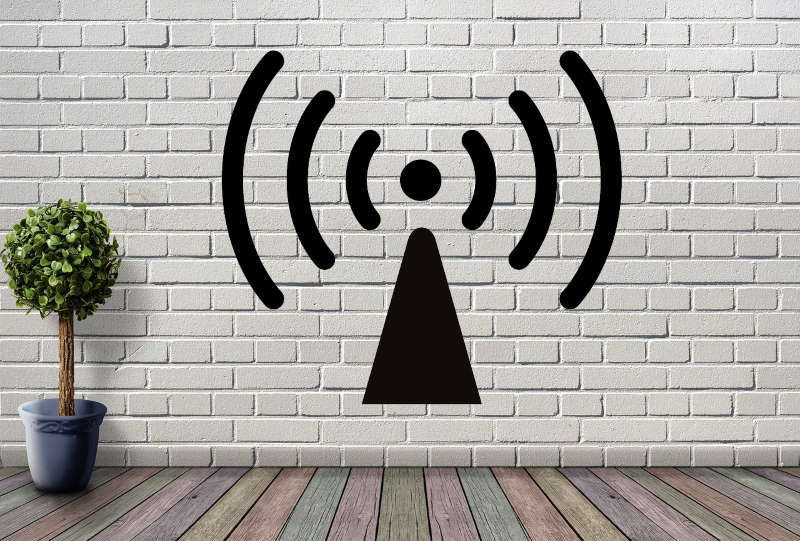Electromagnetic fields (EMFs) are everywhere, but they’re invisible to the human eye. EMF is generated from both the electric field and magnetic field. Electric fields are a result of electric charges, or are created through differences in voltages. Since it is available everywhere, people often ask, does EMF go through the walls?
Walls do not block EMF radiation. To understand how EMF goes through the walls, you need to know its characteristic is defined by frequency or wavelength. An EMF with different frequencies interacts with an object or body in different ways.
Electromagnetic waves come in the form of microwaves, light, AM, and radio-frequency. These waves represent different types of frequencies and the lower the frequency, the easier it is to go through the wall. Light waves can penetrate through the wall in a situation where the wall has a window or it is made of paper. Compared to other types of waves, light has the highest frequency. Therefore, EMF can’t be blocked by walls but can reduce the risk of exposure.
Cellular phones use microwaves and radio frequencies to communicate with each other. Though the radio waves have a low frequency compared to microwaves, they can also penetrate through a wall. Electromagnetic waves travel at a fast speed, usually the speed of light, and the number of oscillations determines the frequency.
Concrete walls can’t block EMF radiation but it can reduce the amount of radiation that passes through the wall.
EMF radiation can also be caused by natural sources. That is, caused by the sun in the form of UV rays. These natural UV rays are not as strong as the EMF radiation that occurs as a result of technology. EMF radiation resulting from technology is a construct of humans, and it includes low-frequency EMF and high frequency or radio waves.
Here’s a video summary of the article if you prefer watching:
How Walls Reduce EMF Waves
Whenever an electrical charge (either positive or negative) is present in a conductor, it generates electric fields. The strength of the fields depends on the voltage flowing. That is, the higher the voltage, the stronger the electric field will be. The fields will always exist even when the current is not flowing. In the home, there are many sources of EMF waves.
Electric fields become strong when close to the charged conductor, and they become weak as distance increases. The field may be significantly reduced only a few meters away from the conductor. They may also be reduced if there is something blocking the signal.
Reducing the amount of radiation is referred to as attenuation. Attenuation in physics is described as the gradual reduction in force as energy goes through the material.
Some natural materials and some constructed building materials have some shielding effect on these fields. Trees, walls and buildings help reduce your exposure to electric fields that come from power lines, cell phone towers, or the electromagnetic fields in your home.
Walls Do Not Completely Block EMF radiation
The effectiveness of walls is very dependent on the construction materials and thickness of the wall. For example, a concrete wall has excellent blocking properties, especially if it is a significant thickness. The amount of radiation reduction achieved depends directly (but not entirely) on how thick the concrete wall is. High-frequency materials also increase the attenuation of concrete walls. The more concrete between you and the source of radiation, the lower the amount of radiation you are exposed to.
If a current is flowing between devices, it generates magnetic fields. These magnetic fields are strong when close to the source and can’t usually be blocked entirely by a wall or buildings. This is just due to the nature of typical construction techniques, materials and standards. Therefore, EMF can go through walls but at the same time, the walls do help reduce the risk of exposure.
You can also use conductors like some metals to shield magnetic fields. For example, aluminum or copper materials attenuate the electromagnetic radiation by absorbing all protons that pass through the material.
Distance from the source is directly related to the level of your exposure to EMF. The radiation effects are always strongest near the source, but as you increase your distance from the radiation source, the risk of exposure reduces correspondingly.
Poor wiring in a building also increases the amount of EMF that you may be exposed to. If the walls are not made of concrete, your level of exposure will be increased. You can read more information about poor wiring here.
How to Protect Yourself from EMF
No matter where you are, you need to protect yourself from EMFs. Electromagnetic fields are everywhere. They are in our homes, at work, and at locations in the community, such as grocery stores and shopping malls.
Even if you spend a lot of time at home, you’re at the risk of absorbing electromagnetic radiation from the devices you use in your everyday lives. Electronic devices and radio transmitting devices at home generate a high amount of EMF radiation.
Some of this EMF radiation is generated by:
- Radio-frequency EMF: The radio frequency (RF) is used for radio communications and consists of energy waves that alternate at a fast rate. RF waves emit radiation that affects individuals.
- Low-frequency EMF: The low-frequency electromagnetic field is emitted by various home appliances such as cell phones, microwaves, Wi-Fi, and other home equipment. They have non-ionizing radiation that forms part of the electromagnetic spectrum
- Low-frequency EMF radiation results in health issues. It can affect the central nervous system. The effects of radiation you will have in your body depend on the frequency of the EMF. High-frequency radiation results in heating effects that increase body temperatures.
You can protect yourself against these radiations by:
1. Knowing how EMF penetrates
Different frequencies of EMF have different penetration properties. Radiation from a low-frequency electromagnetic force does go through walls and floors. The radiation can penetrate through metal, a concrete wall or even bricks. There is no material that blocks low-frequency radiation entirely.
Some materials such as a thick brick or concrete wall can reduce the penetration of radio frequency radiation. Some of these materials act as a shield to minimize penetration of radio frequency waves. Metal sheets are also used sometimes.
Using metal sheets or bricks to block the radio waves will not work unless you block any other possible path, such as a door or window. The radio waves will always bounce off any surface they can’t penetrate and find an alternative path to pass through.
2. EMF gets weaker with distance
EMF radiation gets weaker when the distance from the source increases. For example, low-frequency electromagnetic force gets weaker instantly with increased distance. Therefore getting far away from low-frequency EMF sources protects you from radiation effects.
Radio frequency also gets weaker with distance but at a slow rate, hence the reason why RF is commonly used for communication between devices. Moving farther away from RF/EMF will affect network connection between the communication devices.
You should also know the source of the EMF. Knowing the source will help you increase your distance from it. Low-frequency magnetic fields always pass through walls without an issue. For example, if poor wiring or another source of electromagnetic field is in or next to the wall, you may consider pushing your bed or chair away from the wall.
You cannot install EMF filters, plant radiation absorbing plants, or wear skin patches to absorb radiation. They can’t reduce low-frequency EMF.
3. Appliances should be 3 feet from you
All home appliances generate low-frequency EMF. Small home devices like a cell phone charger have a large amount of radiation. TV, microwaves, washing machines, and other appliances generate EMF radiation.
Low-frequency EMF within the house can extend radiation up to three feet in all directions. When you can, maintain a distance of at least 3 feet away from all home appliances.
4. Switch off wireless devices when not in use
All wireless devices in your home generate radio waves. Devices like cell phones, the wireless router, computers, and printers among others generate a low-frequency EMF.
Therefore, switch off some of these devices when not in use. You can also put your cell phone in airplane mode to reduce EMF exposure. Switch off your phone at night. If you typically use it as an alarm, look for a mechanical alarm clock instead. You should also use Ethernet connections instead of using Wifi connections.
5. Get EMF meter
To reduce your EMF exposure in the house, get an EMF meter so that you can measure the EMF sources in your home. You might not know the amount of radiation you’re exposing yourself to since you can’t feel it or see it. For example when you switch on all the appliances at the same time, a higher overall level of EMF will be present in the home.
The EMF meter monitors and manages EMF exposure in the home. Radio frequency meters are very expensive compared to low-frequency meters. These meters help you reduce your exposure by helping you understand what your EMF sources are so you can manage your exposure levels.
Summary
Electromagnetic Fields (EMFs) come from both natural sources like the sun, and from devices constructed by humans.
EMF radiation is everywhere and it is caused by a variety of devices like cell towers, cell phones, wireless networks (Wifi) and radiation from power lines. Low-frequency EMF radiation is non-ionizing, and devices like cell phones, Wifi, microwaves, and computers contribute to increased radiation in your house or workplace.
The strength of the low-frequency EMF radiation is determined by the distance from the source. The farther away from the source, the weaker the radiation becomes.
The radiation emitted by these devices can penetrate any type of wall. Having a shield between two communicating computers or devices doesn’t block the radiation from penetrating through. By design, the signal must reach the other device in order for them to communicate.
There are ways to reduce your exposure to EMFs. Walls, both constructed and natural, can minimize your exposure. Walls that are thick, and especially those made of concrete effectively reduce the transmission of EMF from room to room. If there are windows and doors, the signal will go through there instead of through the wall.
Natural walls of trees or hedges cannot completely block radiation but they can reduce the amount of radiation you are exposed to. This is because they block and absorb the amount of radiation that passes through them to you. For example, if you live near the powerlines, planting trees between your house and the power lines will help reduce the amount of radiation you’re exposed to.


